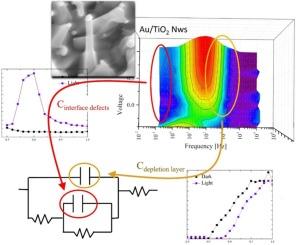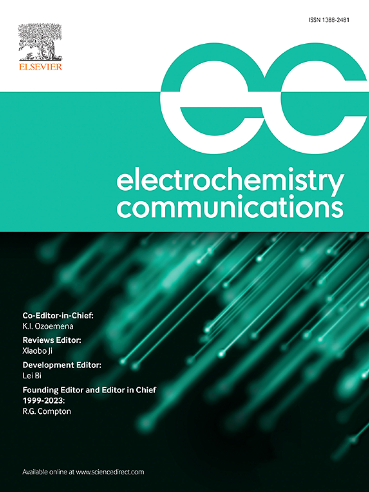Photo-electro-chemical properties of hydrogenated Au/TiO2 nanowires grown by seed-assisted thermal oxidation
IF 4.2
3区 工程技术
Q2 ELECTROCHEMISTRY
引用次数: 0
Abstract
In this paper, we study the electrochemical properties of hydrogenated Au/TiO2 nanowires (NWs) synthesised by seed-assisted oxidation. Hydrogenation was performed electrochemically or by annealing in forming gas. The reduction process leads to a 20× improvement in photocurrent and introduces defects at the nanowires/water interface. At high frequencies, the usual Randles circuit is used. The depletion layer defect density is estimated to be 1016, 1018 and 1020 cm−3 for “as-grown”, “Forming gas” and “electrochemically reduced” samples, respectively. At frequencies lower than the relaxation frequency, defects localised at the nanowire/water interface cause an enhancement in capacitance. Under UV irradiation, a density of 1012 cm−2 can be estimated for these defects at about 0 VAg/AgCl.

种子辅助热氧化法制备氢化Au/TiO2纳米线的光电化学性质
本文研究了种子辅助氧化法制备氢化Au/TiO2纳米线的电化学性能。氢化是通过电化学或在成形气体中退火进行的。还原过程导致光电流提高20倍,并在纳米线/水界面引入缺陷。在高频时,通常使用兰德尔斯电路。对于“生长”、“形成气体”和“电化学还原”样品,损耗层缺陷密度分别为1016、1018和1020 cm−3。当频率低于弛豫频率时,纳米线/水界面处的缺陷会导致电容的增强。在紫外线照射下,这些缺陷的密度可以估计为1012 cm−2,约为0 VAg/AgCl。
本文章由计算机程序翻译,如有差异,请以英文原文为准。
求助全文
约1分钟内获得全文
求助全文
来源期刊

Electrochemistry Communications
工程技术-电化学
CiteScore
8.50
自引率
3.70%
发文量
160
审稿时长
1.2 months
期刊介绍:
Electrochemistry Communications is an open access journal providing fast dissemination of short communications, full communications and mini reviews covering the whole field of electrochemistry which merit urgent publication. Short communications are limited to a maximum of 20,000 characters (including spaces) while full communications and mini reviews are limited to 25,000 characters (including spaces). Supplementary information is permitted for full communications and mini reviews but not for short communications. We aim to be the fastest journal in electrochemistry for these types of papers.
 求助内容:
求助内容: 应助结果提醒方式:
应助结果提醒方式:


